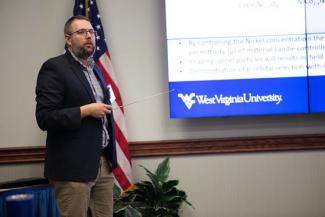The University Coalition for Basic and Applied Fossil Energy Research and Development (UCFER), which was established in 2015 to promote collaboration among NETL and 15 universities, is preparing to conclude the seven-year effort, which resulted in more than $16 million of federal funding awarded to 43 research projects that significantly advanced energy research, including clean energy projects focused on developing carbon management technologies. The Coalition comprised of 15 member universities including the Pennsylvania State University (Penn State) as the prime recipient.
“NETL is focused on a wide array of decarbonization technologies, and working with some of the top universities in the nation allows the Lab to explore research developed through unique perspectives,” said NETL’s Omer Bakshi, UCFER project officer. “Over the last seven years, UCFER has developed an impressive portfolio in priority research areas such as carbon capture, carbon conversion, fuel cell technologies, direct air capture and many other areas that are critical to reaching a carbon emissions-free economy by 2050.”
Collaboration with NETL was a major part of each project. NETL staff supported each project by offering consultation, technical guidance, sample analysis, sample preparation and more. The Lab also provided internships for the universities and made NETL’s cutting-edge facilities available to coalition participants, with researchers also co-mentoring students and co-authoring journal articles and conference papers. Participants authored a total of 53 journal articles, with 33% co-authored by NETL researchers. Additionally, participants produced 267 papers, presentations and posters for workshops and conferences, with 19% of the conference papers co-authored by NETL staff.
Some examples of UCFER projects designed to advance clean energy include the following:
- Efficient Reduction of Carbon Dioxide (CO2) in a Bipolar Electrochemical Cell — Penn State. A new type of bipolar membrane electrochemical cell was developed with the goal of reducing CO2 into useful products. This technical accomplishment was enabled by the advanced membranes and catalysts synthesized at Penn State. The advantage of this plasma-assisted catalysis approach is that it converts methane to high-value chemicals and fuels in a one-step process. NETL’s Doug Kauffman consulted with the Penn State team. NETL and Penn State also worked together to find follow-on funding for full-cell testing studies.
- Methane Emissions Quantification Compressor Stations — Virginia Polytechnic Institute and State University. An atmospheric measurement system was installed at an active natural gas compressor station in central Appalachia and monitored methane emissions in real-time continuously for five months. NETL loaned the project team a forward-looking infrared camera that was used throughout multiple site visits.
- Autothermal Methane Decomposition for Large-Scale Co-production of CO2-free Hydrogen and Aligned Carbon Nanotube — West Virginia University. Researchers developed a novel catalytic process to enable co-producing hydrogen and solid carbon products, which improves the overall economics of large-scale hydrogen production from natural gas. Intellectual property and publications as a result of this project are joint efforts between WVU and NETL.
- Computer Vision and Machine Learning Making the Processing-Microstructure-Property Connection in Heat Resistant Alloys — Carnegie Mellon University. The team assembled a data set of microstructural images and their associated property metadata, developed computer vision (CV) image representation models to develop a CV approach to quantify the visual information, and then chose machine learning methods suitable for learning from the selected image representation. NETL collaborators included a team led by Michel Gao.
- Core-Shell Metal Organic Frameworks (MOFs) for Direct Air Capture — University of Pittsburgh. Researchers were able to identify optimal core-shell MOFs to selectively bind CO2 over nitrogen and water through computational screening. This work lays the foundation for future research using core-shell MOFs for direct air capture and similar gas separation applications. The team collaborated with NETL’s Janice Steckel.
- Crosslinked Microspherical Adsorbents from Lignite-derived Humic Acid for CO2 Capture — University of North Dakota. The team developed a low-cost, multi-functional and high-performance adsorbent for CO2 capture from lignite-derived humic acid. Results from this project contributed to a deeper understanding of the “process-structure-performance” relationship associated with the development of the microspherical potassium carbonate-based solid adsorbent for CO2 capture. NETL’s James Hoffman attended regular monthly meetings and provided insightful technical advice during the project period through his expertise in CO2 capture.
“These are just a sampling of the projects made possible through this multi-year coalition,” Bakshi said. “The clean energy breakthroughs made over the last seven years demonstrate the vast potential for university-national lab partnerships to help meet research and development needs as the nation transitions to a clean energy economy.”
At closing, the 15 universities comprising UCFER were: Carnegie Mellon University, Louisiana State University, Massachusetts Institute of Technology, The Ohio State University, The Pennsylvania State University, Princeton University, Texas A&M University, University of Kentucky, University of North Dakota, University of Pittsburgh, University of Utah, University of Southern California, University of Wyoming, Virginia Tech and West Virginia University.
NETL is a U.S. Department of Energy national laboratory that drives innovation and delivers technological solutions for an environmentally sustainable and prosperous energy future. By leveraging its world-class talent and research facilities, NETL is ensuring affordable, abundant and reliable energy that drives a robust economy and national security, while developing technologies to manage carbon across the full life cycle, enabling environmental sustainability for all Americans.




